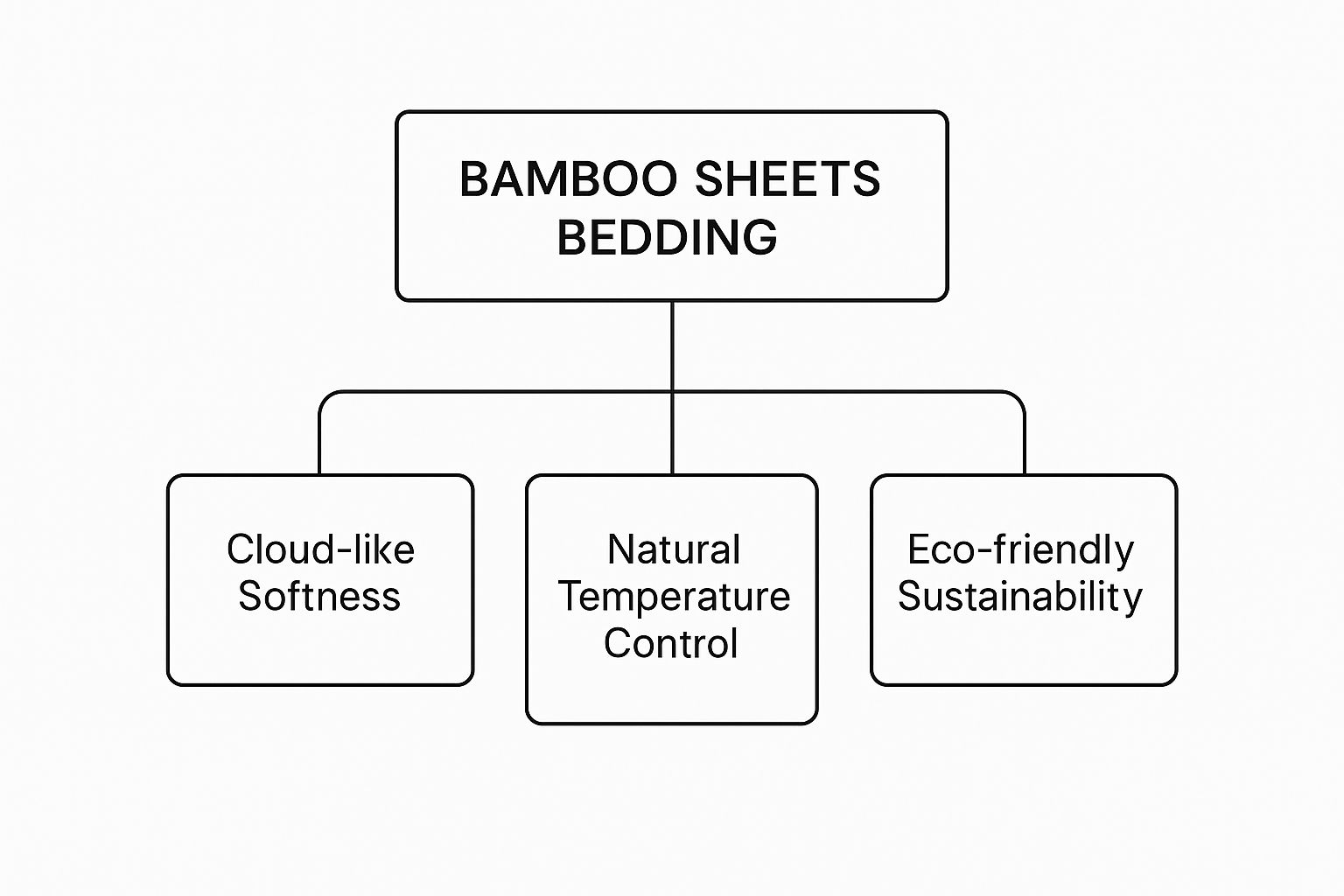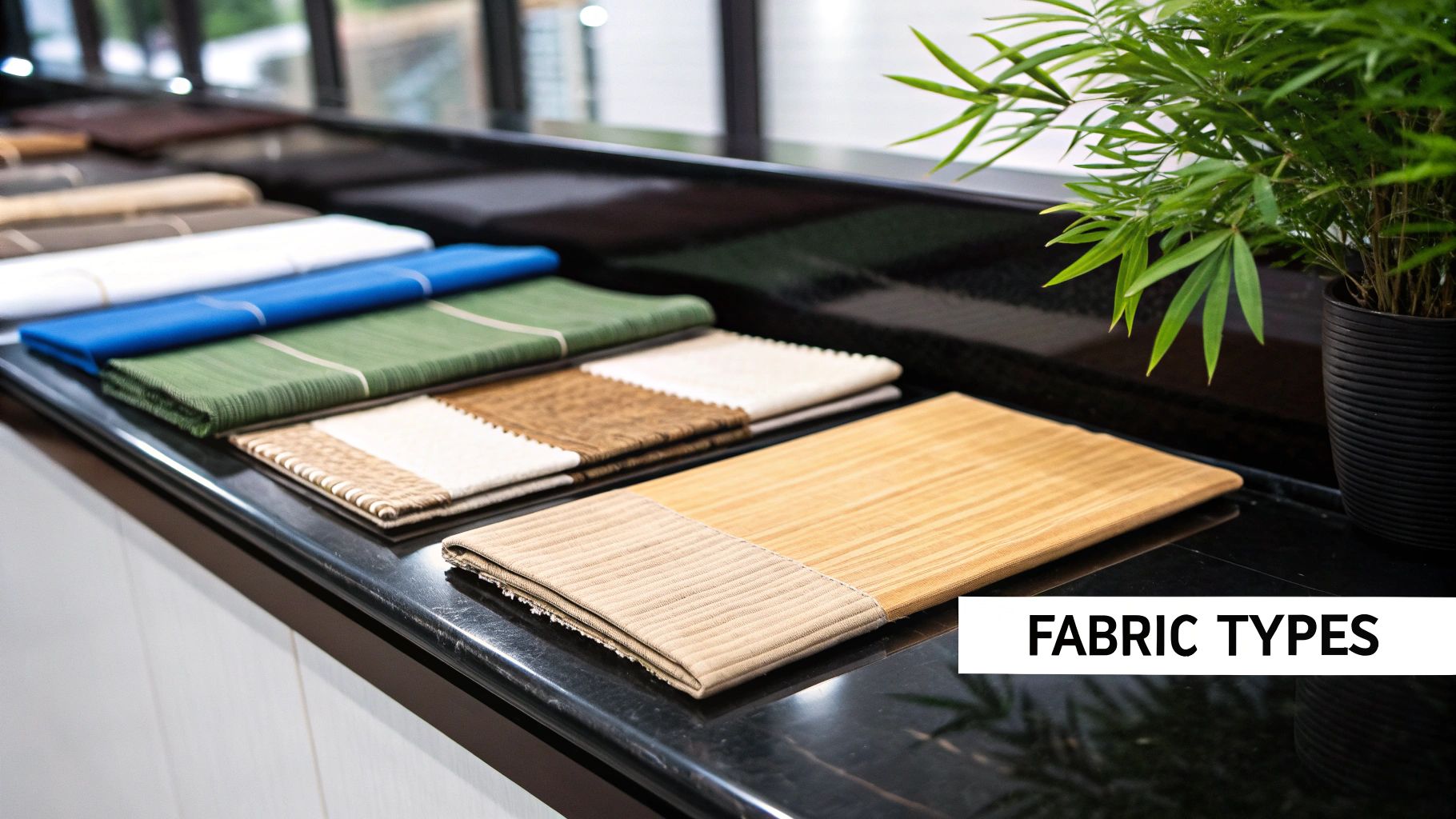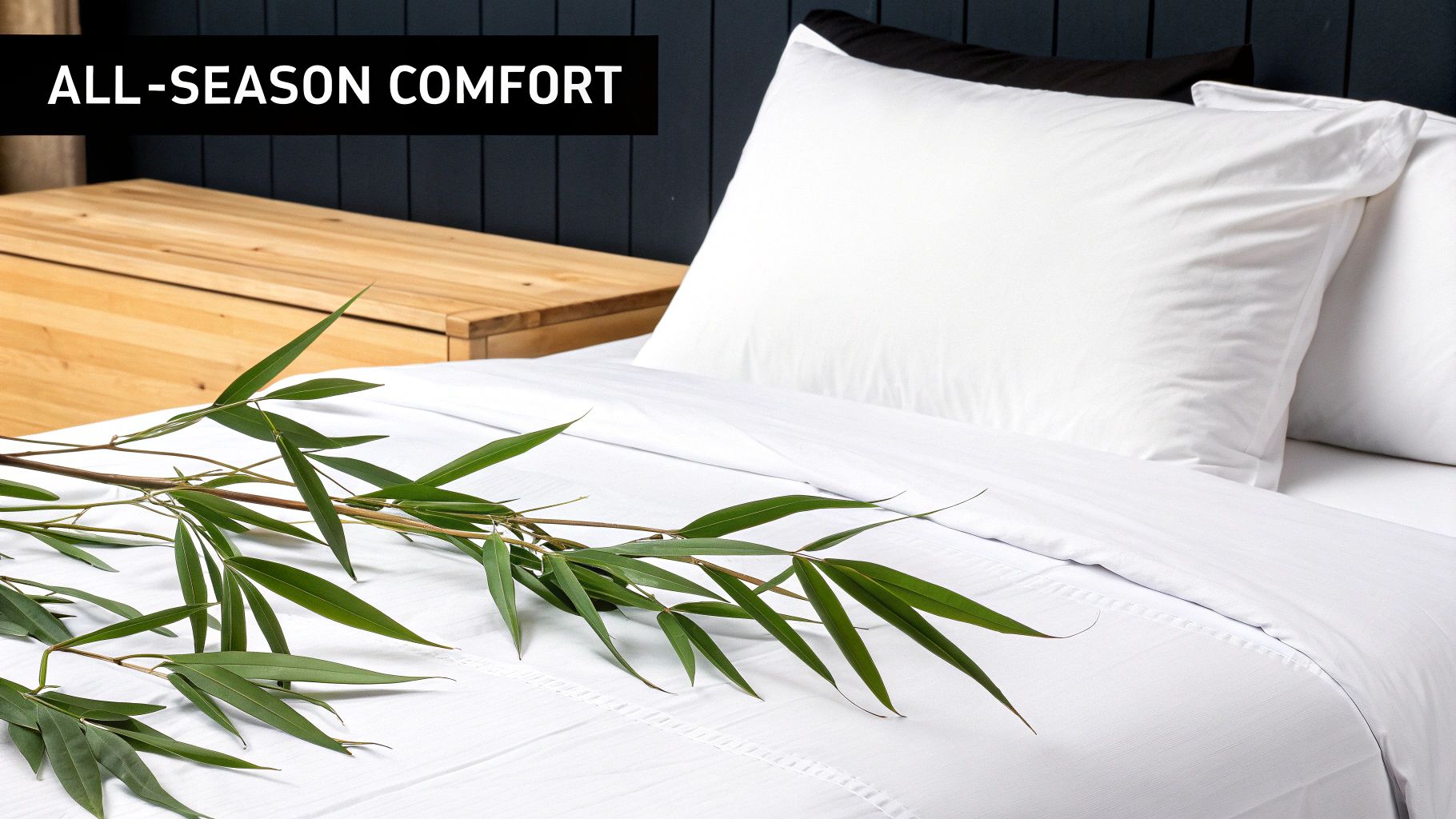Tired of nights spent tossing and turning, feeling too hot or too cold? Imagine slipping into sheets so silky-smooth they feel like a cool cloud against your skin. That's the unique comfort of bamboo sheets bedding. This guide cuts through the hype to give you clear, actionable advice on choosing, using, and loving these game-changing sheets.
Bamboo fabric is celebrated for two simple reasons: it feels incredibly soft and is brilliant at regulating your temperature all night long. If you've ever woken up tangled in sweaty cotton sheets, you'll understand why this is a true sleep revolution. The secret lies in the long, smooth fibres of the bamboo plant, which create a fabric that's gentle on skin and naturally breathable.
Why Are Bamboo Sheets So Popular?
The buzz around bamboo bedding isn't just clever marketing—it comes from a genuinely superior sleep experience. Unlike traditional cotton that can feel scratchy or trap heat, bamboo fabric offers a luxurious feel that many compare to a blend of silk and cashmere.
This incredible softness comes directly from the natural structure of bamboo fibres. They are long, smooth, and rounded, free from the tiny spurs that can irritate sensitive skin. This makes bamboo sheets a fantastic choice for anyone with allergies or skin conditions like eczema. For a deeper look, check out our guide on the advantages of bamboo sheets.
The Secret to Their Success
So, why are so many people making the switch? Beyond the luxurious feel, bamboo sheets offer practical benefits perfect for the Australian climate. The fabric is highly breathable and excels at wicking moisture away from your body, keeping you cool in summer and cosy in winter.
A key driver in this trend is the growing demand for sustainable, high-quality materials. According to recent research, the Australian bed linen market is projected to reach USD 20,238 million by 2033, with a significant portion of this growth attributed to eco-friendly options like bamboo. You can read the full report on the Australian bed linen market trends.
This infographic neatly summarises the appeal.

The real magic is where luxurious comfort, practical temperature control, and sustainability meet. This powerful combination creates a truly better sleep environment.
Finally, bamboo is a highly renewable resource. It grows incredibly fast with minimal water and no need for pesticides, making it a far more environmentally sound choice than many other textiles. This blend of personal comfort and planetary care is what makes bamboo bedding special. It's an investment in better sleep for you and a lighter footprint on the earth.
Decoding the Different Types of Bamboo Fabric
When you shop for bamboo sheets bedding, you'll see terms like viscose, rayon, and lyocell. While it might seem confusing, the difference is straightforward—it all comes down to how the raw bamboo pulp is turned into the silky fabric you love.
The manufacturing process is what sets them apart, influencing the feel, durability, and environmental impact of the final product. The two main types you'll encounter are Bamboo Viscose and Bamboo Lyocell.

Bamboo Viscose: The Popular Choice
Bamboo Viscose is the most common type of bamboo fabric, prized for its incredible softness and affordability. The process involves dissolving bamboo pulp with chemicals before spinning it into fine fibres. While this method has faced environmental scrutiny, modern manufacturing has become much cleaner. Our guide explains in detail what viscose from bamboo is.
Think of viscose as your perfect entry point into bamboo bedding. It delivers that signature silky feel and breathability without the premium price tag.
Bamboo Lyocell: The Eco-Friendly Innovator
Bamboo Lyocell represents the next generation of bamboo textiles, thanks to its clean manufacturing process. It uses a non-toxic solvent in a "closed-loop system," where over 99% of the solvent and water are captured and reused. This dramatically reduces waste and environmental impact.
This cleaner process results in a fabric that is exceptionally soft, strong, and one of the most eco-friendly options available. Lyocell sheets are known for their durability, making them a fantastic long-term investment.
Quick Comparison Guide
Here’s a simple table to help you decide.
| Fabric Type | Feel and Texture | Production Process | Environmental Impact | Best For |
|---|---|---|---|---|
| Bamboo Viscose | Incredibly soft, silky, and drapes beautifully | Chemically intensive process, though modern methods are improving | Higher impact, but varies by manufacturer | Budget-conscious shoppers seeking signature bamboo softness. |
| Bamboo Lyocell | Exceptionally smooth, strong, and luxurious feel | Non-toxic solvent used in a closed-loop system | Very low impact and highly sustainable | Eco-conscious buyers wanting superior durability and a premium feel. |
Your choice depends on your priorities. Are you focused on finding the softest sheets for your budget, or is sustainability your top concern? Both deliver an incredible night's sleep. To get a wider perspective, you can Explore other common blanket materials like fleece, sherpa, and woven fabrics.
The Real Benefits of Sleeping on Bamboo Sheets
The magic of bamboo sheet bedding goes beyond its silky feel; it’s about how the fabric actively works to improve your sleep. The unique structure of bamboo fibres delivers tangible benefits, from keeping you cool to soothing sensitive skin.

The first thing most people notice is the incredible temperature regulation. If you're a "hot sleeper" who constantly kicks off the covers, bamboo sheets are a revelation.
Stay Cool and Dry All Night
The microscopic structure of bamboo fibres is filled with tiny gaps that create natural ventilation. This allows body heat to escape far more effectively than with cotton, preventing that stuffy, trapped feeling. The fabric is also brilliant at wicking moisture away from your skin, helping it evaporate quickly so you stay dry and comfortable.
- For Hot Sleepers: This means you stay cooler, leading to deeper, more restorative sleep.
- For Cold Sleepers: In winter, these same fibres act as a natural insulator, trapping warm air close to your body without causing overheating.
A Gentle Touch for Sensitive Skin
If you have sensitive skin, allergies, or eczema, the wrong fabric can ruin your night. Bamboo sheets are naturally hypoallergenic, meaning they are far less likely to cause irritation. The fibres are incredibly smooth and round, gliding over your skin rather than scratching it.
A real-world example: A customer who often woke up with itchy, red skin from their cotton-blend sheets switched to bamboo. They found the irritation vanished because the smooth fabric reduced friction as they moved, allowing them to sleep soundly through the night.
Durability That Lasts
You might think something so soft must be delicate, but high-quality bamboo sheets are surprisingly tough. With proper care, they can easily outlast cotton, resisting pilling and holding their shape for years. Better yet, they get softer with every wash. For comparison, you can read about the advantages of bamboo cotton sheets.
How to Choose the Perfect Bamboo Sheets
Ready to make the switch to bamboo sheets? Picking the right set is simpler than you think. Let's walk through what really matters so you can find the perfect sheets for your best night's sleep.

First, forget what you know about thread count. For cotton, a high thread count often means higher quality. With bamboo, this isn't the case. The long, smooth fibres create incredible softness with a much lower thread count—usually between 300 and 500. Instead, focus on the weave and certifications.
Weave Determines the Feel
The way bamboo fibres are woven together dramatically affects how they feel. You'll mainly find two types: sateen and twill.
- Sateen Weave: If you love a silky, five-star hotel feel, sateen is for you. It has a gorgeous lustre and a smooth, liquid-like drape that feels cool to the touch.
- Twill Weave: This weave has a more textured, matte appearance and is exceptionally durable. It’s still wonderfully soft but is built to last, making it a great option for busy households.
Actionable Insight: A hot sleeper who loves a luxurious feel should choose a sateen weave. A family with pets or young children might prefer the durability of a twill weave.
Look for Quality Certifications
Certifications are your shortcut to peace of mind. They guarantee you're buying a product that's safe, well-made, and free from harmful chemicals. The most important one to look for is the OEKO-TEX® STANDARD 100 label.
This certification means every component of the product—from the fabric to the thread—has been tested for harmful substances. Seeing this label ensures your sheets are safe for you and your family.
Choosing certified products from trusted brands like Sienna Living ensures you get the premium, healthy sleep experience you deserve. The growing trends in the Australian bedsheet market show a clear shift towards high-quality, certified products. When you're ready, explore our full range of bamboo bedding to find your perfect match.
Keeping Your Bamboo Bedding Soft for Years
You’ve invested in the cloud-like comfort of bamboo sheets bedding, and keeping them that way is simple. It’s all about gentle care and avoiding a few common mistakes that can damage the natural fibres. The golden rule? Treat them gently with cold water and mild detergents.
The Ideal Washing Routine
For best results, wash your sheets in cold water (no more than 30°C) on a gentle cycle. Hot water can cause the fibres to shrink and lose their softness over time. Use a mild, liquid detergent and wash them separately from rough items like towels or jeans to prevent pilling.
Common Mistakes to Avoid
The two biggest mistakes are using fabric softener and high dryer heat. Fabric softener coats bamboo fibres with a waxy film, clogging the micro-gaps that make them breathable. This traps heat and makes the sheets feel stiff over time.
Practical Tip: Instead of fabric softener, add a quarter-cup of white vinegar to the rinse cycle once a month. It naturally softens the fabric and removes any detergent residue without causing damage. For a complete guide, learn how to wash bamboo sheets correctly.
Drying, Stains, and Storage
How you dry your sheets is just as important as how you wash them. High heat is the enemy of bamboo fibres.
- Best Method: Line drying in the shade is ideal. It keeps them soft and prevents colour fading.
- Alternative Method: If using a dryer, select the lowest heat setting or an air-dry cycle. Pull them out when they're still slightly damp to prevent over-drying and wrinkles.
For stains, act fast by blotting the area and treating it with a gentle stain remover. When storing, choose a cool, dry linen cupboard and avoid plastic containers that can trap moisture.
Ready for a Better Night's Sleep?
Choosing the right bedding is one of the most effective ways to transform your sleep. We've covered why bamboo sheets bedding is a standout choice—from its unmatched comfort and health benefits to its sustainable origins. Think of it as an investment in your well-being.
By embracing the unique softness and breathability of bamboo, you're not just making your bed cosier; you're creating a better sleep ritual. Great sheets are a huge piece of the puzzle, but for a holistic approach, you might find this article on unlocking the secrets to better sleep and recovery insightful.
Research from the Sleep Health Foundation indicates that poor sleep can negatively impact mood, concentration, and long-term health. Investing in your sleep environment is a direct investment in your daily energy and overall quality of life.
Ready to feel the difference for yourself? Explore our collection of 100% organic bamboo sheets and discover what a truly restorative night's sleep feels like.
Your Bamboo Sheets Questions, Answered
Thinking about making the switch to bamboo sheets bedding? It’s normal to have questions. Here are straightforward answers to the most common queries we receive.
Do Bamboo Sheets Wrinkle Easily?
Yes, natural fibres like bamboo will wrinkle more than synthetic blends, but less than linen. The wrinkles are usually soft folds, not sharp creases.
Actionable Tip: To minimise wrinkles, pull your sheets from the dryer while they are still slightly damp. Put them directly on your bed, and the weight of the fabric will naturally smooth them out as they finish air-drying.
Are Bamboo Sheets Better Than Egyptian Cotton?
It's not about "better," but what's better for you.
- Choose Bamboo if you want a silky-smooth, cool-to-the-touch feel. It’s ideal for hot sleepers due to its superior breathability and moisture-wicking properties.
- Choose Egyptian Cotton if you prefer a classic, crisp hotel-bed feel. It’s known for its durability and distinct texture.
If a cool, buttery-soft feel and sustainability are your priorities, bamboo is the clear winner.
How Long Do Bamboo Sheets Last?
With proper care, a quality set of bamboo sheets will last for five to seven years or even longer. The key is following the care label: wash in cold water on a gentle cycle and avoid high heat and fabric softeners. Gentle care preserves the integrity of the natural fibres, making your investment last. For more details, check our frequently asked questions about bamboo bedding.
Do Bamboo Sheets Pill Over Time?
Pilling is rare with high-quality bamboo sheets. It happens when short fibres break, so the long, strong fibres of bamboo are naturally resistant. To prevent it, wash your sheets separately from rough items and stick to a gentle wash and dry routine.
A great night's sleep is about more than just sheets. To optimise your entire routine, consider reading about unlocking the secrets to better sleep and recovery.
Conclusion: Transform Your Sleep Tonight
Upgrading to bamboo sheets is a simple, effective way to improve your sleep quality and overall well-being. With their unparalleled softness, temperature-regulating properties, and eco-friendly benefits, they offer a luxurious experience that helps you wake up refreshed and ready for the day.
Ready to transform your bedroom into a sleep sanctuary?

